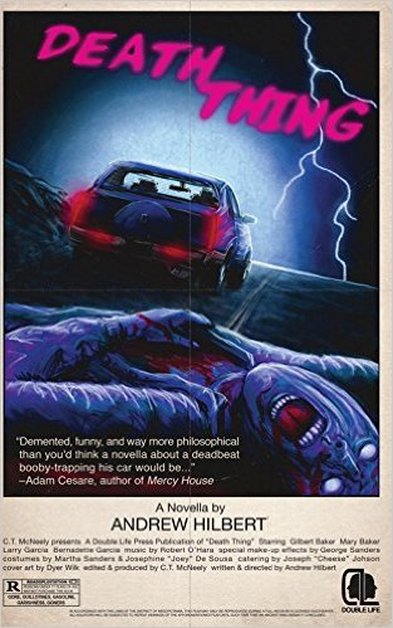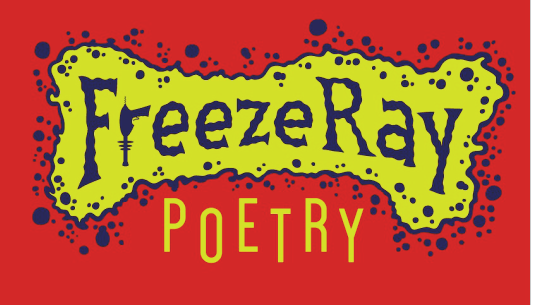
Death Thing by Andrew Hilbert
Double Life Press
www.doublelifepress.wordpress.com
reviewed by Eric Morago
The premise of Andrew Hilbert’s novella, Death Thing, published by Double Life Press, is deceivingly simple. The story follows Gilbert, a man fed up with hoodlums breaking into his car and with a society that has seemingly become complacent with crime, as he decides to take matters into his own hands. He then sets out to wage a deranged war on would-be thieves by turning his car into a booby-trapped killing monstrosity. It isn’t long (within the first ten pages) before Gilbert’s “death thing” butchers its first baited bum—from there, the narrative spirals forward, taking both its characters and reader down an unhinged road. While Death Thing is pulp and fun and can easily be dismissed as an indulgence, Hilbert’s acute attention to style and craft elevates his novella to something more than just a dime-store read—an imaginative exploration into an everyman’s dark nature.
Gilbert’s motivation is one most readers can relate to. Many of us have known the anger that swells from being a victim of vandalism or theft. By tapping into this, Hilbert creates a morally compromised character that, while extreme in his actions, still garners our sympathy. While his “death thing” succeeds in its purpose, Gilbert’s story is not one without great loss. Very early in the narrative, while fine-tuning one of his car’s traps, Gilbert severely burns his face and is horribly disfigured. From that point on, his whole head is always bandaged and vividly described in some gory manner. Hilbert does an excellent job using Gilbert’s external appearance to reflect the character’s morality. Every time Gilbert falls deeper and deeper into an amoral abyss, his oozing scabs pull open underneath his bandages, suggesting this is a man incapable of redemption by his body’s inability to heal.
Hilbert’s vivid imagery and clever use of symbolism is not his story’s only strength. Death Thing reads like absurdist theatre or an episode of the Twilight Zone.
With its small cast of characters, the narrative feels intimately isolated. And like work by Beckett or Serling, Hilbert’s story creates its own intriguing reality—one where gruesome killings go completely unnoticed by society, or worse, are encouraged. It’s a hard pill to swallow, but once the reader suspends their disbelief they are treated to an entertaining, yet provocative morality play.
Speaking of plays—Hilbert has an excellent ear for dialogue. One could easily see the text lifted off the page and read aloud by actors. His characters’ words and exchanges are always fluid and flawlessly serve to propel the story’s action forward. With Death Thing, Hilbert truly shows his horrific plot unfold, never distancing the reader by telling. Death Thing is something of a freak show that the reader cannot help but fixate on until they start to see a small part of themselves in its deformity.
All that said, Death Thing isn’t without its flaws. Hilbert chooses to break the story into sections—each focusing on Gilbert or other characters his actions affect. I have no problem with this narrative convention, but I don’t think Hilbert executes it as well as he could here. The sections feel unbalanced, especially when the first of the story--Gilbert—makes up almost two thirds of the whole book. A lot of great stuff takes place in that first section, and while what happens in the other sections are indeed pivotal to the story, I can’t help but feel they distractingly fracture the plot some, more than help it along. I also felt the ending was rushed; Hilbert introduces and shifts narrative focus onto two new important characters in the final section that is only thirty pages long. The story and Gilbert’s arc comes to a sudden close, not unlike the swift death of someone killed by a booby-trapped car. While the book’s narrative always moves at an amusingly quick pace, I believe its ending to be a little disjointed when compared to the myriad of other strengths the novella has going for it.
Flaws aside, Death Thing, is most certainly a book worth your time, if you are someone who is comfortable exploring something dark, something that doesn’t pull its punches when showing us a grotesque caricature of ourselves, or something ridiculous and real at the same time. Hilbert’s novella may be guised as pulp (Just look at its amazing cover made to look like a grindhouse VHS box cover!), but it’s also powerful. Do yourself a favor and take Hilbert’s Death Thing for a ride…it will be a fun way to kill…
…a few hours.
Double Life Press
www.doublelifepress.wordpress.com
reviewed by Eric Morago
The premise of Andrew Hilbert’s novella, Death Thing, published by Double Life Press, is deceivingly simple. The story follows Gilbert, a man fed up with hoodlums breaking into his car and with a society that has seemingly become complacent with crime, as he decides to take matters into his own hands. He then sets out to wage a deranged war on would-be thieves by turning his car into a booby-trapped killing monstrosity. It isn’t long (within the first ten pages) before Gilbert’s “death thing” butchers its first baited bum—from there, the narrative spirals forward, taking both its characters and reader down an unhinged road. While Death Thing is pulp and fun and can easily be dismissed as an indulgence, Hilbert’s acute attention to style and craft elevates his novella to something more than just a dime-store read—an imaginative exploration into an everyman’s dark nature.
Gilbert’s motivation is one most readers can relate to. Many of us have known the anger that swells from being a victim of vandalism or theft. By tapping into this, Hilbert creates a morally compromised character that, while extreme in his actions, still garners our sympathy. While his “death thing” succeeds in its purpose, Gilbert’s story is not one without great loss. Very early in the narrative, while fine-tuning one of his car’s traps, Gilbert severely burns his face and is horribly disfigured. From that point on, his whole head is always bandaged and vividly described in some gory manner. Hilbert does an excellent job using Gilbert’s external appearance to reflect the character’s morality. Every time Gilbert falls deeper and deeper into an amoral abyss, his oozing scabs pull open underneath his bandages, suggesting this is a man incapable of redemption by his body’s inability to heal.
Hilbert’s vivid imagery and clever use of symbolism is not his story’s only strength. Death Thing reads like absurdist theatre or an episode of the Twilight Zone.
With its small cast of characters, the narrative feels intimately isolated. And like work by Beckett or Serling, Hilbert’s story creates its own intriguing reality—one where gruesome killings go completely unnoticed by society, or worse, are encouraged. It’s a hard pill to swallow, but once the reader suspends their disbelief they are treated to an entertaining, yet provocative morality play.
Speaking of plays—Hilbert has an excellent ear for dialogue. One could easily see the text lifted off the page and read aloud by actors. His characters’ words and exchanges are always fluid and flawlessly serve to propel the story’s action forward. With Death Thing, Hilbert truly shows his horrific plot unfold, never distancing the reader by telling. Death Thing is something of a freak show that the reader cannot help but fixate on until they start to see a small part of themselves in its deformity.
All that said, Death Thing isn’t without its flaws. Hilbert chooses to break the story into sections—each focusing on Gilbert or other characters his actions affect. I have no problem with this narrative convention, but I don’t think Hilbert executes it as well as he could here. The sections feel unbalanced, especially when the first of the story--Gilbert—makes up almost two thirds of the whole book. A lot of great stuff takes place in that first section, and while what happens in the other sections are indeed pivotal to the story, I can’t help but feel they distractingly fracture the plot some, more than help it along. I also felt the ending was rushed; Hilbert introduces and shifts narrative focus onto two new important characters in the final section that is only thirty pages long. The story and Gilbert’s arc comes to a sudden close, not unlike the swift death of someone killed by a booby-trapped car. While the book’s narrative always moves at an amusingly quick pace, I believe its ending to be a little disjointed when compared to the myriad of other strengths the novella has going for it.
Flaws aside, Death Thing, is most certainly a book worth your time, if you are someone who is comfortable exploring something dark, something that doesn’t pull its punches when showing us a grotesque caricature of ourselves, or something ridiculous and real at the same time. Hilbert’s novella may be guised as pulp (Just look at its amazing cover made to look like a grindhouse VHS box cover!), but it’s also powerful. Do yourself a favor and take Hilbert’s Death Thing for a ride…it will be a fun way to kill…
…a few hours.
